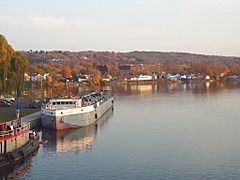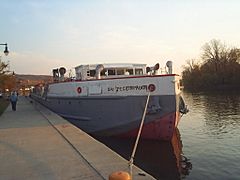Day Peckinpaugh facts for kids
Quick facts for kids |
|
|
Day Peckinpaugh
|
|

Day Peckinpaugh docked at Albany on her maiden voyage in 1921
|
|
| Location | Matton Shipyard, Van Schaick Island, Cohoes, New York |
|---|---|
| Built | 1921 |
| Architect | McDougal-Duluth, MN, builder; Todd Shipyard, Brooklyn, NY, rebuild |
| Architectural style | canal motorship |
| NRHP reference No. | 05001486 |
| Added to NRHP | December 28, 2005 |
The Day Peckinpaugh is a special historic boat called a motorship. It's currently docked at the Matton Shipyard in Cohoes, which is in Albany County, New York, United States. This boat is important because it's a piece of history from the canal system.
Contents
Building a Special Boat
The Day Peckinpaugh was built in 1921 by the McDougall-Duluth Shipyard in Duluth, Minnesota. It was the very first boat designed specifically for the New York State Canal System. This canal system is the modern version of the famous Erie Canal.
The ship was first named ILI101. This name came from its first owner, a company called Interwaterways Lines Inc. The Day Peckinpaugh was special because it could travel on the big, open waters of the Great Lakes. But it was also narrow enough to fit through the small locks and shallow parts of the canal.
This boat is the last one left from a group of over 100 similar ships. These ships used to carry goods all the way from the middle of the United States to New York City.
How Big Was It?
The Day Peckinpaugh is about 259 feet long and 36 feet wide. This makes it one of the largest boats that could operate on New York's canal system. The canal locks are 300 feet long and 43.5 feet wide, so it was a tight squeeze!
The boat had a deep storage area, about 14 feet deep. It could carry a lot of stuff, up to 1,650 tons! This made it great for carrying large amounts of goods like wheat, flax seed, rye, sugar, and even pig iron (a type of metal) in its early days. It was known as a bulk carrier.
First New Name
In 1922, the ILI101 got a new name: Richard J. Barnes. This was to honor the person who first ordered the ship to be built.
Helping in World War II
During World War II, the Richard J. Barnes was called into service by the United States Merchant Marine. Its job was to carry coal and refuel other cargo ships along the east coast of the United States.
While serving, the Richard J. Barnes was attacked by a German U-boat (a submarine). The U-boat fired a torpedo at the ship. Luckily, the torpedo was thought to have passed right under the ship. This was because the Richard J. Barnes had a very shallow draft (how deep the boat sits in the water), only about seven feet.
Second New Name
In 1958, the ship was sold to a company called Erie Navigation. They changed the boat to carry sand and gravel. The ship was renamed again, becoming the Day Peckinpaugh. This new name honored a man who was the brother of a famous New York Yankees baseball player and manager, Roger Peckinpaugh.
Later Jobs
In 1961, the ship was changed again. It became a self-unloading boat that carried dry cement. It transported cement from Oswego to Rome, New York. The Day Peckinpaugh kept doing this job until it retired in 1994. It was the last self-propelled commercial boat that regularly carried goods on the barge canal.
Bringing it Back to Life
In 2005, the Day Peckinpaugh was saved from being taken apart at a scrap yard. Several museums and groups that wanted to save the canal's history worked together. The ship is now being cleaned, painted, and fixed up. Its engines are also being tested.
More than $3 million has been promised to help restore the Day Peckinpaugh. The plan is to turn it into a floating classroom and museum. It will teach people about the history of the Erie Canal and the Great Lakes. In 2011, the New York State Education Department received a grant to help make the Day Peckinpaugh a learning center. The restoration was planned to finish in 2012. The Day Peckinpaugh is the biggest item in the New York State Museum collection.
Almost Sunk!
On March 8, 2010, something scary happened. The ship was almost completely sunk while it was docked for repairs. Someone went onto the boat and opened some valves to let water in. The goal was to sink the ship.
State Police and ship workers quickly pumped the water out of the ship's engine rooms. The Day Peckinpaugh was very close to being underwater. The flooding caused a lot of damage, costing over $10,000 to fix.
Where is it Now?
The Day Peckinpaugh was added to the National Register of Historic Places in 2005. At that time, it was in Lockport. But its main home for repairs and between trips is in Cohoes.
The Day Peckinpaugh and another old boat, the 1901 tugboat Urger, are still working vessels. They act like traveling ambassadors for the New York State Barge Canal System, showing off its history.
Gallery
-
Day Peckinpaugh closeup at Waterford, New York (November 2005)





